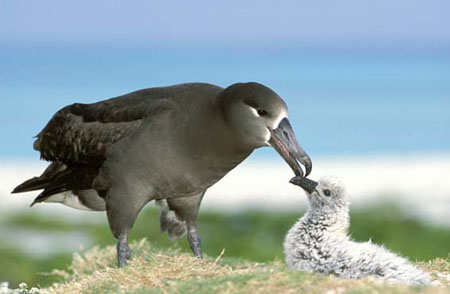| Diomedeidae () |
| 81 cm TL (male/unsexed); max.weight: 3,000.0 g |
|
others; marine |
| Pacific Ocean and Northwest Atlantic: from the coasts of China, Japan and Russia eastward to continental North America. Tropical to temperate waters. |
|
Culmen: 12.7 cm; tarsus: 9.74 cm; wing: 21.3 cm. |
| Total Length: 68 to 74 cm (Ref. 8812). Found in the open ocean (Refs. 356, 122680). Scavengers (Ref. 356). Exhibits surface seizing behavior (Refs. 356, 122680). Courtship display preceding mating pair formation involves fanning both wings simultaneously while touching its side with its bill. Nests inland on Midway Island in calm areas; go to edge of islands and utilize updrafts to get airborne. Nesting site defended by aggression in the form of overt attack biting, threat with wide gape and vocalization, and rapid bill-clapping. Shifts between pairs in incubating eggs are long to allow far-foraging; longest recorded distance of a breeding individual of this species is 3700 km from its colony. Unable to regulate body temperature while still in the egg, even in late-incubation embryos with pip-holes; hatchlings, however, are able to regulate body temperature in response to environmental conditions. Semi-precocial. Postfledging care about 40 days. High mercury levels on feathers of young from Midway, north Pacific Ocean. Vulnerable to long-line fisheries (Ref. 87784) |
|
Near Threatened (NT); Date assessed: 14 August 2020 (A3cd) Ref. 123251)
|
|
|
Source and more info: www.sealifebase.org. For personal, classroom, and other internal use only. Not for publication.

